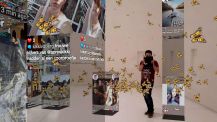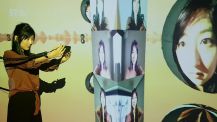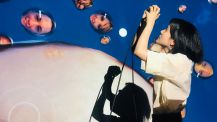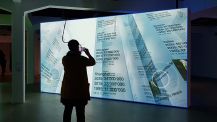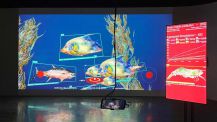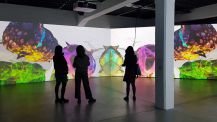360° Mobile VR Art Apps are research projects for interactive art installations that are shown in museums, galleries and at media art festivals. The mobile display can be projected onto one or more walls in the exhibition space. Visitors can interact via smartphone or tablet and thus become performers. These experimental projects were developed in close collaboration with artists, authors, engineers, musicians, scientists and the Intelligent Sensor-Actuator-Systems Laboratoy (ISAS) at the Karlsruhe Institute of Technology (KIT). Please install the mobile apps on your smartphone or tablet and embark on an interactive experiment.
Overview 360° Mobile VR Art Apps
- Mobile Apps
- Versions in Comparison
- Exhibition Space
- Download
- Credits
10.000 Moving Cities – Same but Different
Mobile App as Interface for Net-Based Installations
10.000 Moving Cities – Same but Different focuses on how places are constantly changing and cities are becoming more and more similar. Any city can be selected on a world map or searched by hashtag. Up-to-date and relevant social media posts are searched, processed and transferred into the virtual world. With this app you can see and hear what’s happening in real-time around the world. An endless flow of countless stories. You experience how our world is constantly changing and how more and more places are becoming “non-places”, as described in Marc Augé’s book and essay “Non-places”. You become an observer and at the same time you can actively participate.
more…
10.000 Moving Cities – Same but Different, AR (Augmented Reality)
Mobile App, AR Single- and Multiplayer Game
High towers rise into the sky, every place becomes a city.
With the Augmented Reality App 10.000 Moving Cities – Same but Different, AR one moves between the imaginary buildings via smartphone and tablet and participates in the digital communication streams and social movements of our time by means of inserted Social Media Posts. The buildings can be destroyed and rebuilt by the users. But beware! Everyone sees what the other is doing from different perspectives. The more buildings disappear, the more creatures appear.
more…
Single- and Multiplayer Version
CAON – control and optimize nature
Mobile App for Interactive Installations
CAON – control and optimize nature explores the potential of advanced technologies in the management of future ecosystems. In a habitat where animal, fungi, and plant species have been modified by technologies such as 3D printing, CRISPR and synthetic biology, you can observe how an AI optimizes and balances a delicate ecosystem.
more…
Friends
Mobile App as Interface for Net-Based Installations
In December 2018, NVIDIA shook the world by showing how easily Artificial Intelligence can create ultra-realistic portraits of people who do not exist. Friends leverages the results of this research and offers an immersive experience experimenting with the massive amount of AI-generated content. Using a mobile phone, countless faces are generated and stare at the user from all directions. All the ordinary looking portraits of people are fake: they are randomly generated by AI. The portraits are projected into a navigable 3D environment and rotate so that they are constantly looking at the user, also to reference social media profile images.
more…
Me, Myself & I
Mobile App as Interface for Interactive Installations
Me, Myself & I questions egocentrism and narcissism as widespread contemporary phenomena and their most popular, in-famous declination: the selfie culture. The digital era emphasizes the individual, who are seen more and more at the center of society, rather than being part of it. With Me, Myself & I, you virtually float over urban cityscapes in love with yourself and become an egocentric superstar in which altruism no longer has a place.
more…
MORE AND LESS – flying through a three-dimensional Book
Mobile App as Interface for Net-Based Installations
In MORE AND LESS – flying through a three-dimensional book, media art, lyrics, facts about population development and extinct animals are brought together in a unique interdisciplinary project. Since 1950, the urban world population has risen by over three billion people. The world’s population continues to grow from today’s 7.6 billion to an estimated 9.8 billion people in 2050. People are in need of more space, and animals habitats are being threatened. Some animal species have died out and become extinct; such as the European Terrestrial Leech, the Pyrenean Ibex, and the Chinese Freshwater Dolphin. Every day, a three-digit number of species perish. From a European perspective, many animals disappear in remote areas unnoticed. How do people and artists deal with this constellation?
more…
Nonplace – the Age of the Anthropocene
360° Mobile VR App
Nonplace – the Age of the Novacene investigates the relationship between humans and nature in the Novocene era. The 360° media art mobile VR app deals with the loss of identities through technological progress and globalisation and poses the question of what it means when cities, shopping centres, everyday objects, etc. become more and more similar. In Nonplace – the Age of the Novacene, you fly through an endless futuristic city. You cover the skyscrapers with images that are taken automatically by the app.
more…
Speculative Evolution
Mobile App for Interactive Installations
Speculative Evolution imagines a speculative ecosystem 30 years from now, where artificial intelligence and biotechnologies work together to create and optimize species to withstand the increasingly hostile environment. From the perspective of an AI simulator, the audience is invited to create new variations of animals, fungi, plants, and robots, fly with these engineered and mutated species, and observe the changing ecosystem. Speculative Evolution responds to the trend of technology-assisted solution-making by constructing narratives of an uncomputable system under extreme control – what do we optimize, and what are we ignoring as a result? The project aims to inspect our tendency to simplify complex ecosystems by treating nature as a system that can be fixed
more…
Time to Nest Time to Migrate
Mobile App for Interactive Installations
With this 360° New Media Art Mobile VR App Time to Nest Time to Migrate you fly through your own inner world. What happens in there? Bacteria, cells, fungi, parasites, phages, protists, prions, viruses communicate. Do they determine what we are? Not scientific, but rather fake scientific, philosophical and emergency poetically. (We know that we know nothing, we know). A little dance of life and death. The project evokes a sense of wonder, enchantment, entanglement and admiration for the unknown in our body and its microscopic world. The images, texts and spoken words come from microbiological research, mainly from universities, and transform it into an interactive poetic dance.
more…
YANTO – yaw and not tip over
Mobile App for Interactive Installations
YANTO – yaw and not tip over is a speculative piece on the future of aquafarming. The narrative sets in a speculative fish farm 30 years from now, where artificial intelligence and synthetic biology work together to create an optimized environment for farmed species. A simulator powered by artificial intelligence creates hybrid species to balance a delicate ecosystem in this imagined scenario.
more…
Versions in Comparison
| Mobile App | Released | Medium | Platform | Costs |
| 10.000 Moving Cities, Mobile App | 2018-ongoing | 360° New Media Art Mobile VR App | Android | CHF 350.- |
| 10.000 Moving Cities, AR | 2018-ongoing | Augmented Reality Mobile App, Single- and Multiplayer Game | Android and iOS | free* |
| Friends | 2019-ongoing | 360° New Media Art Mobile VR App | Android | free* |
| Me, Myself & I | 2018-ongoing | 360° New Media Art Mobile VR App | Android | free* |
| MORE AND LESS | 2020-ongoing | 360° New Media Art Mobile VR App | Android | free* |
| Nonplace | 2018-ongoing | 360° New Media Art Mobile VR App | Android | free* |
| Speculative Evolution | 2024-ongoing | 360° Medienkunst Mobile VR App | Android | free* |
| Time to Nest Time to Migrate | 2020-ongoing | 360° New Media Art Mobile VR App | Android | free* |
Exhibition Space
In the exhibition space, the mobile display can be projected onto one or more walls. As two mirroring projections, the image doubles kaleidoscopically. Visitors can interact using smartphones or tablets and become performers. The animations and sounds follow the user’s movements: the virtual environment rotates as the user turns the device. The sky appears when the device is moved upwards. When the device is tilted downwards, the floor appears. The virtual environment is infinite and can be navigated in all directions. The sound experiences are specially composed for the apps and respond to all these movements and navigation modes.


Material for one projection:
1x Android smartphone
1x sound systems
1x HD projector


Material for two projections:
1x Android smartphone
1x sound systems
2x HD projectors
1x HDMI splitter
Download 360° Mobile VR Art Apps in the Play Store
Install the apps and experiment with them on your smartphone or tablet.
Credits
Antonio Zea is an Ecuadorian research engineer. He resides in Germany and works in the fields of data visualization, robotics, and augmented reality. In 2017, he received his Ph.D. in computer science at Karlsruhe Institute of Technology. Since then, he has continued his research at the Intelligent Sensor-Actuator-Systems chair and is currently working for his habilitation.
Birgit Kempker is Swiss based poet. Research in the fields: word, image, sound. space, idea, concept and consciousness. Writes for art in art as art. Thinking drawings. Drawing words. Prose, essay, song, sound, radio plays. poetry, radio, collaborations, sphinx. mountains of MEANING as such. Research and teaching at University of Applied Sciences and Arts Basel (FHNW)
Florian Faion is a German research engineer, working in the fields of sensor data fusion and artificial intelligence. In 2015, he received the Ph.D. in computer science at Karlsruhe Institute of Technology. Since 2018, he is working at Bosch Corporate Research on deep learning based perception with application to automated driving.
Iris Qu Xiaoyu is a Chinese artist and technologist based in Brooklyn, NY, working at the intersection of software engineering and new media art. With code as her primary medium, her work engages with the speculative, political, and poetic aspects of technology. Her current research focuses on the hidden cost of optimization in machine learning systems.
Markus Kirchhofer is a Swiss freelance author since 2013. Before that he was a cultural mediator, teacher and adult educator. He writes poems, short stories, picture stories/comics, columns and plays. His literary work has received several awards, most recently a contribution from the Swiss Arts Council Pro Helvetia. His most recent publication: “aushub” (100 poems, Knapp Verlag, September 2018).
Shervin Saremi is an Iranian musician and audio-engineer, working in fields such as sonic computing, procedural sound design, and production. He has studied Electronic Production and Design at Berklee College of Music and is pursuing his research on immersive audio at Berlin University of the Arts (UdK).
The Intelligent Sensor-Actuator-Systems Laboratory (ISAS) at the Karlsruhe Institute of Technology (KIT) deals with a variety of challenges in systems and state estimation including tracking, stochastic control, distributed estimation and telepresence.

